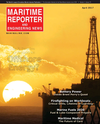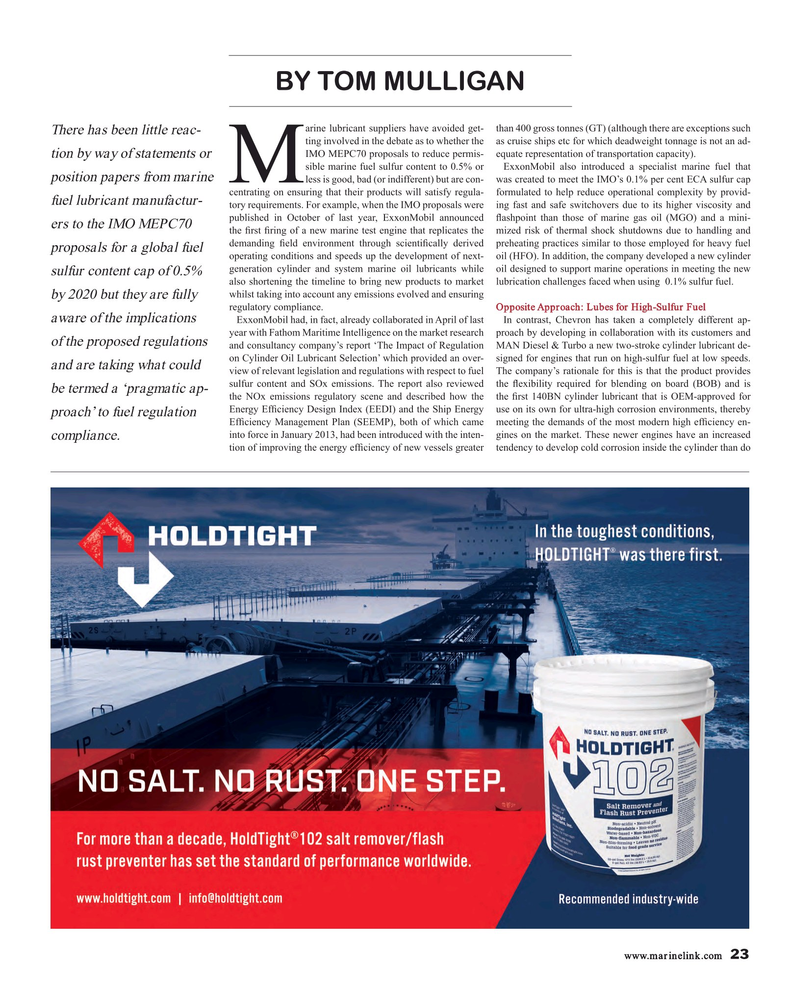
Page 23: of Maritime Reporter Magazine (April 2017)
The Offshore Annual
Read this page in Pdf, Flash or Html5 edition of April 2017 Maritime Reporter Magazine
BY TOM MULLIGAN arine lubricant suppliers have avoided get- than 400 gross tonnes (GT) (although there are exceptions such
There has been little reac- ting involved in the debate as to whether the as cruise ships etc for which deadweight tonnage is not an ad-
IMO MEPC70 proposals to reduce permis- equate representation of transportation capacity).
tion by way of statements or sible marine fuel sulfur content to 0.5% or ExxonMobil also introduced a specialist marine fuel that position papers from marine
Mless is good, bad (or indifferent) but are con- was created to meet the IMO’s 0.1% per cent ECA sulfur cap centrating on ensuring that their products will satisfy regula- formulated to help reduce operational complexity by provid- fuel lubricant manufactur- tory requirements. For example, when the IMO proposals were ing fast and safe switchovers due to its higher viscosity and published in October of last year, ExxonMobil announced ? ashpoint than those of marine gas oil (MGO) and a mini- ers to the IMO MEPC70 the ? rst ? ring of a new marine test engine that replicates the mized risk of thermal shock shutdowns due to handling and demanding ? eld environment through scienti? cally derived preheating practices similar to those employed for heavy fuel proposals for a global fuel operating conditions and speeds up the development of next- oil (HFO). In addition, the company developed a new cylinder generation cylinder and system marine oil lubricants while oil designed to support marine operations in meeting the new sulfur content cap of 0.5% also shortening the timeline to bring new products to market lubrication challenges faced when using 0.1% sulfur fuel.
whilst taking into account any emissions evolved and ensuring by 2020 but they are fully regulatory compliance. Opposite Approach: Lubes for High-Sulfur Fuel aware of the implications
ExxonMobil had, in fact, already collaborated in April of last In contrast, Chevron has taken a completely different ap- year with Fathom Maritime Intelligence on the market research proach by developing in collaboration with its customers and of the proposed regulations and consultancy company’s report ‘The Impact of Regulation MAN Diesel & Turbo a new two-stroke cylinder lubricant de- on Cylinder Oil Lubricant Selection’ which provided an over- signed for engines that run on high-sulfur fuel at low speeds. and are taking what could view of relevant legislation and regulations with respect to fuel The company’s rationale for this is that the product provides sulfur content and SOx emissions. The report also reviewed the ? exibility required for blending on board (BOB) and is be termed a ‘pragmatic ap- the NOx emissions regulatory scene and described how the the ? rst 140BN cylinder lubricant that is OEM-approved for
Energy Ef? ciency Design Index (EEDI) and the Ship Energy use on its own for ultra-high corrosion environments, thereby proach’ to fuel regulation
Ef? ciency Management Plan (SEEMP), both of which came meeting the demands of the most modern high ef? ciency en- into force in January 2013, had been introduced with the inten- gines on the market. These newer engines have an increased compliance. tion of improving the energy ef? ciency of new vessels greater tendency to develop cold corrosion inside the cylinder than do www.marinelink.com 23
MR #4 (18-25).indd 23 MR #4 (18-25).indd 23 4/4/2017 2:02:04 PM4/4/2017 2:02:04 PM

 22
22

 24
24
